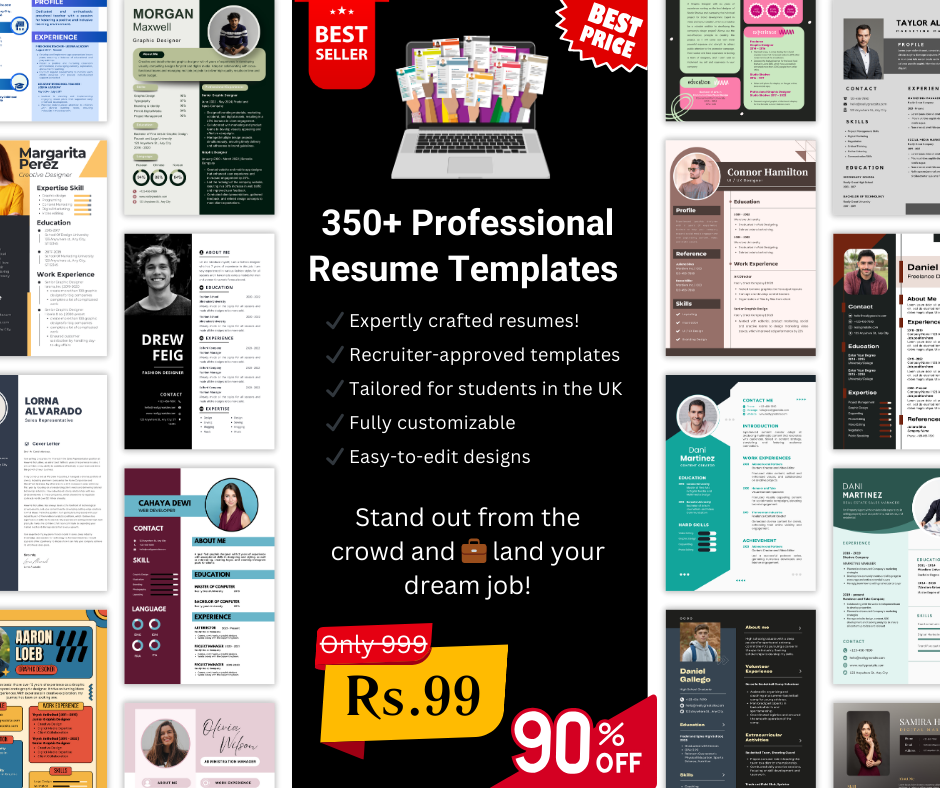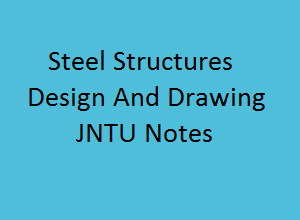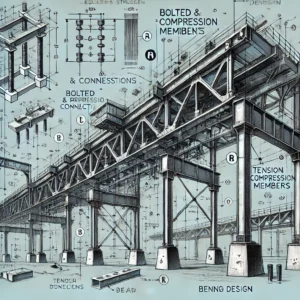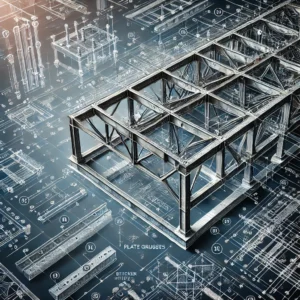Here you can download Design of Steel Structures Notes pdf – DSS notes pdf materials with multiple file links to download. The Design of Steel Structures Pdf free download (design of steel structures lecture notes pdf) starts with the topics covering Making of iron and steel, Bolted connections-Riveted connections, Design of tension members, Design of compress in members, Design of Beamss, Design of eccentric connectiom, Design of plate girders, Design of roof trusses, Etc.
Design of Steel Structures Notes pdf – DSS notes pdf file
Complete Design of Steel Structures Pdf free download
Link:Complete Notes
Unit 1
Link:Unit 1 Notes
Unit 2
Link:Unit 2 Notes
Note :- These notes are according to the R09 Syllabus book of JNTU.In R13 and R15,8-units of R09 syllabus are combined into 5-units in R13 and R15 syllabus. If you have any doubts please refer to the JNTU Syllabus Book.
Topics of design of steel structures lecture notes pdf
UNIT – I
Materials – Making of iron and steel – types of structural steel – mechanical properties of steel – Concepts of plasticity – yield strength. Loads — and combinations local buckling behaviour of steel. Concept of limit State Design – Limit States – Design Strengths- deflection limits – serviceability – stability eck.
UNIT – II
Bolted connections-Riveted connections –IS – 800-2007 – specifications – Design strength – efficiency of joint _ prying action. Welded connections — Types of welded joints – specifications – design requirements.
UNIT – III
Design of tension members— Design strength – Design procedure splice – lug angle.
UNIT – IV
Design of compress in members – Buckling class – slenderness ratio / strength design – laced – battened columns — splice – column base – slab
UNIT – V
Design of Beamss-Plastic moment – Bending and shear strength/buckling – Builtup sections – laterally / supported beams.
UNIT – VI
Design of eccentric connectiom – Framed – stiffened / seat connection.
UNIT – VII
Design of plate girders – elements – economical depth – design of main Section – connections between web and flange – design of stiffness bearing – intermediate stiffeners – Design of Websplica & Flange splica.
UNIT – VIII
Design of roof trusses – Types of roof trusses, loads on trusses — purlin design – truss design, Design of joints and end bearings.
Design of Steel Structures Notes PDF – JNTU Lecture Notes DSS – B.Tech Notes 2025
Design of Steel Structures (DSS) Notes PDF is an essential resource for B.Tech students, particularly those from JNTU (Jawaharlal Nehru Technological University). These notes provide a comprehensive understanding of Design of Steel Structures concepts, covering topics such as tension and compression members, bolted and riveted connections, beam design, plate girders, roof trusses, and more. With these lecture notes, students can grasp the essential design principles required for designing steel structures in various applications.
DSS Notes PDF
The DSS Notes PDF offers in-depth knowledge of structural steel design, which is a core subject for civil engineering students. These lecture notes provide detailed explanations of important topics, from the mechanical properties of steel to the design of bolted and welded connections, as well as the design of tension, compression members, and beams. This makes the Design of Steel Structures Notes PDF an indispensable guide for both exams and practical applications in the field of civil engineering.
Design of Steel Structures PDF Lecture Notes – JNTU
Design of Steel Structures (DSS) is a key subject in civil engineering, and JNTU provides a well-structured set of lecture notes to assist students in understanding the fundamental concepts and design procedures. The DSS Notes PDF follows the B.Tech 2024 syllabus, covering a wide range of topics such as plasticity, buckling behavior, limit state design, bolted and welded connections, and roof truss design.
Design of Steel Structures Notes, PDF | DSS B.Tech (2025)
The Design of Steel Structures (DSS) Notes PDF for B.Tech 2024 is a complete resource, offering a step-by-step approach to the design of structural steel elements. This PDF covers various essential topics such as buckling strength, beam design, eccentric connections, plate girders, and roof trusses. It is a crucial reference for civil engineering students preparing for their exams or engaging in steel structure design projects.
Description: Design of Steel Structures PDF, Syllabus, Books | B.Tech (2025)
Design of Steel Structures (DSS) focuses on the application of steel in the design of structural elements. These lecture notes provide an overview of important concepts such as the mechanical properties of steel, buckling behavior, and limit state design. They also include detailed discussions on bolted and welded connections, tension members, compression members, beams, plate girders, and roof trusses.
Overview: DSS Notes PDF
The DSS Notes PDF from JNTU provides a comprehensive set of lecture notes that are indispensable for B.Tech civil engineering students. These notes cover the essential principles required to design various steel structures such as beams, columns, and connections. With detailed explanations and examples, students can easily understand how to apply these principles in real-world scenarios.
The following topics are covered in Design of Steel Structures Handwritten Notes:
- Materials – Introduction to the making of iron and steel, types of structural steel, and their mechanical properties.
- Bolted and Riveted Connections – IS 800-2007 specifications, design strength, joint efficiency, and prying action.
- Welded Connections – Types of welded joints, design requirements, and specifications.
- Tension Members – Design strength and design procedure for tension members, splice, and lug angles.
- Compression Members – Buckling behavior, slenderness ratio, laced and battened columns, column base design.
- Beams – Plastic moment, bending strength, shear strength, and design of laterally supported beams.
- Eccentric Connections – Framed and stiffened connections, design of seat connections.
- Plate Girders – Design of main sections, web and flange connections, bearing and intermediate stiffeners.
- Roof Trusses – Types of roof trusses, design of purlins and trusses, and design of joints and end bearings.
Links to Download Design of Steel Structures Notes PDF
Below are the links to download the Design of Steel Structures Notes PDF:
Complete Notes
Download Complete DSS Notes PDF
Unit 1 – Materials and Steel Types
Download Unit 1 Notes PDF
Unit 2 – Bolted and Riveted Connections
Download Unit 2 Notes PDF
For additional reference, you can also check out the older materials that follow the previous syllabus structures. These are equally helpful for exam preparation and project work.
Design of Steel Structures Notes and Study Material PDF Free Download
The Design of Steel Structures (DSS) Notes PDF is available for free download, offering students access to high-quality educational material for their B.Tech courses. These notes provide comprehensive coverage of steel structure design topics, with easy-to-follow explanations that make them suitable for both self-study and exam preparation.
Topics Covered in Design of Steel Structures Notes PDF
The Design of Steel Structures Notes PDF covers a wide range of topics, essential for mastering the subject:
- Materials – Properties of structural steel, yield strength, and plasticity.
- Bolted and Riveted Connections – Joint efficiency, prying action, and design strength.
- Welded Connections – Design requirements, types of welded joints, and IS 800-2007 specifications.
- Tension Members – Design procedure for tension members, splice design, and lug angles.
- Compression Members – Buckling strength, slenderness ratio, and design of laced and battened columns.
- Beams – Plastic moment, bending and shear strength, and design of built-up sections.
- Eccentric Connections – Design of framed, stiffened, and seat connections.
- Plate Girders – Design of web and flange connections, stiffeners, and economical depth.
- Roof Trusses – Design of roof trusses, loads on trusses, and purlin design.
Design of Steel Structures Notes PDF from JNTU
The Design of Steel Structures Notes PDF from JNTU is one of the most valuable resources for students studying civil engineering. These notes align with the latest syllabus, offering detailed guidance on the design of steel structures such as beams, columns, plate girders, and roof trusses. They are designed to help students gain a solid foundation in the principles of structural steel design, making them indispensable for both academic and professional growth.
Always Choose Smartzworld to Download Design of Steel Structures Notes PDF
Smartzworld is the ideal platform to download Design of Steel Structures Notes PDF for free. These notes are meticulously prepared to cover all the essential topics in the DSS syllabus, helping students excel in both academic and practical aspects of steel structure design. By choosing Smartzworld, you ensure access to regularly updated, high-quality lecture notes for free.
Benefits of FREE Design of Steel Structures Handwritten Notes PDF
- Comprehensive Coverage – Covers all important topics, from material properties to the design of roof trusses.
- Exam Preparation – The notes are designed to help students understand the key concepts needed for exam success.
- Free Access – The notes are available for free download, making them accessible anytime.
- Handwritten Notes – Handwritten notes offer a personal touch, making it easier for students to understand complex concepts.
- Regular Updates – These notes are frequently updated to reflect the latest advancements and syllabus changes.
FAQs
Q1. Where can I download the Design of Steel Structures Notes PDF?
You can download the Design of Steel Structures Notes PDF from the provided links for each unit or the complete set from Smartzworld.
Q2. How to download the DSS Notes PDF?
Simply click on the download links provided in the article to access the notes for each unit or the complete set.
Q3. How many modules are covered in DSS Notes PDF?
The DSS Notes PDF is divided into five modules, covering topics such as tension members, compression members, beam design, and roof trusses.
Q4. Topics Covered in DSS Notes PDF?
The topics covered include the design of tension members, compression members, beams, bolted and welded connections, eccentric connections, plate girders, and roof trusses.
Q5. Where can I get the complete DSS Handwritten Notes PDF FREE Download?
You can download the complete DSS Handwritten Notes PDF for free by following the provided links.
Q6. How to download DSS Handwritten Notes PDF?
Click on the provided download links for free access to the DSS Handwritten Notes PDF.
Q7. How to Download FREE DSS Notes PDF?
You can download the free DSS Notes PDF by clicking on the links available for each unit or the complete set.
This content is designed to provide B.Tech students with SEO-optimized, comprehensive information on Design of Steel Structures Notes, helping them easily access and download their lecture notes for effective study and exam preparation.
Reference:
l. Design of Steel structures by K.S, Sai Ram, Person Education.
2. Design of Steel Structures Edwin H. Gaylord, Ir. Charles N. Gaylord and James Stallmeyer Tata McGraw-Hill Education pvt. Ltd. _
3. Design of Steel Structures Vol. 1 & 2 – Ramchandra,Standard Publications
4. Design of steel structures, Structures , S.S.. Bhavikatti, IK int Publication House. New Delhi, 2010.
Text books:
l. Design of steel structures – N. Subramanian, Oxford University Press – 2009.
2. Limit State Design of steel structures. S.K. Duggal, Tata McGraw-Hill, 2010.
Follow us on Facebook and Support us with your Like



